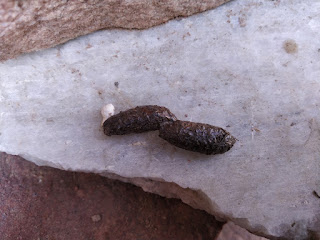How much time do you devote to thinking about poop? I don’t mean your own personal poop, or even the poop of your personal pets. I mean poop as a phenomenon that spans the natural world. Meta-poop, if you will. Almost every living thing out there takes in some form of nourishing substance, and a little while later says Aloha to the unneeded bits. And the organisms on our little space marble have evolved a startling array of defecatory diversity. Let’s take a gander at few of the many crappy ways Nature has found to move the mail, and what to do with the mail once it has reached journey’s end.
Throughput
When animals
do the doo-doo, it can hit town in shapes and conditions that give one pause.
Take wild turkeys. A male of the type produces J-shaped turds, while a female’s
deposit is shaped rather like an obese Slinky with a melanin disorder. Some
snake poo is readily identifiable, not just because it contains bits of bone
and hair, but because it greets the world as an oblong gobbet of semi-liquid
goop, topped off by a soupçon of white urea, giving the glob of guck a jaunty
white-hatted appearance. Orb-weaver spiders turn out feces with a startling
similarity to bird droppings, in which they hide to avoid detection by, well,
birds. Both African and Asian elephants eat a tremendous amount of plant matter
every day, but they have inefficient digestive systems, meaning the departing
dung can look an awful lot like the shrubbery that originally undertook the voyage
through Gutland.
A Loaf of Shite
When you get
down to it, though, the Scatademy Award for Animal with Idiosyncratic Ordure
must surely go to the common wombat. Wombats are marsupials, and males of the
species are obsessed with two things; their territorial boundaries, and finding
a mate. The two activities are not mutually exclusive. As male wombats patrol
their territory, which they do throughout the day, they deposit up to 100 odiferous
bricks of brown signage all around the fence-line.
But they don’t place their portions just any old location. No, they find spots where their feces will be the most noticeable, like on top of a rock. You can always tell when an individual chunk of fecal cake came from a wombat, because male wombat poop parcels are cube-shaped.
And, to answer the question you are undoubtedly
thinking, male wombats do not have Euclidean anuses (though the scientific
debate about that went on way too long). They do have peculiar digestive
tracts, however, which is why they contrive such singular stools. Other male
wombats smell the stuff to learn about possible rivals, while female wombats
get scads of information about possible mates. It’s like Tinder for wombats,
except less gross.
BM Brunch
If you are a pet owner then you probably have a better than passing familiarity with various kinds of nonhuman night soil. You may have observed Junior watching his pet rabbit, Hasenpfeffer, chowing down on its goods, usually fresh from the assembly line, and panicked at the thought of having to answer Junior’s inevitable questions. A similar need for uncomfortable explanations may have arisen when Fido helped himself to a few kitty crunchies from the cat box. Or there was that time when one of Ms. Fido’s puppies made a deposit on the kitchen floor, and Ms. Fido calmly slurped it up, while your offspring shrieked and made gagging noises.
Eating poop is called coprophagia.
It’s a sign of mental discord when humans do it, but it’s quite common among
animals. The two-toed sloth, however, takes the practice to an almost freakish
extreme.
The Peruvian Amazon is home to a couple of different species of dyadically-dactyled sloths, and they behave much like sloths elsewhere – they are impressively slow-moving, they appear to wear permanent grins (see above pic), their fur is home to an entire ecosystem of insects and fungi, and they only leave the trees once each week, in order to take a dump. Sloths deposit their tushy tidbits at the base of the same tree every time. Although theories abound, no one is precisely sure why they do this.
Nor is anyone
sure why the little weirdos feast on fecal matter. Especially since the
fecal matter they feast on is not their own. It’s ours. First observed
in 2010, and now documented many times, two-toed sloths aren’t the least bit squeamish
about filling their empty tum-tums with heaping helpings of human bowel muffins,
and while that’s mildly disturbing, a further pair of points make the behavior
even disturbinger.
First, if
you’ve never seen a sloth moving on the ground, you’ve missed something truly heart-rending. And
second, their ideal dung-diners are the basins beneath our outhouses. They
access the buffet by squirming inside through the seat holes, and then just
settle in for a prolonged nosh. The same scientists who are unsure why sloths
crap under the same tree, are more unsure why sloths feel the need to have
brunch in the places where we leave the remains of our own recent repasts. The
two-toed sloth, if I might paraphrase Arthur Sullivan, is the very model of a coprophagic
animal.
And on that very unfunny note, I bid you farewell. Until next time, here’s wishing you enjoyable, efficacious elimination.







I love this narrative non-fiction! Massively entertaining as well as informative... can't stop chuckling.
ReplyDelete